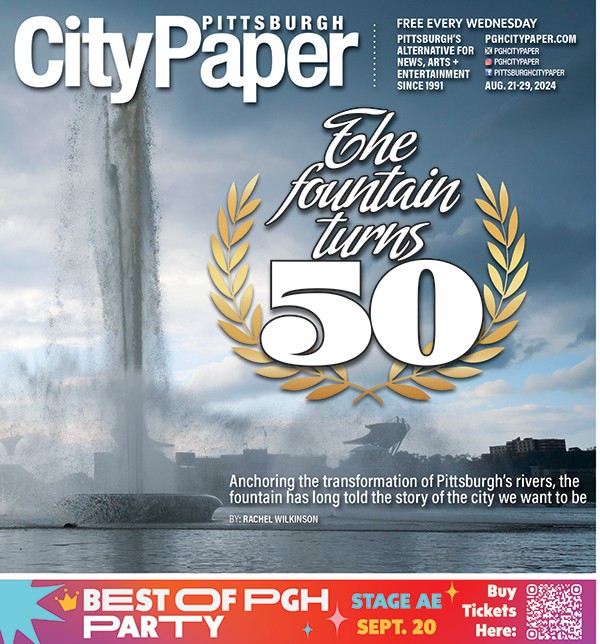Okay, I have to ask: Is there really an underground river that provides the water to the fountain at the Point?
Question submitted by: Susan Benintend, Mount Washington
[
{
"name": "Local Action Unit",
"component": "24929589",
"insertPoint": "3",
"requiredCountToDisplay": "1"
}
]
Everyone does have to ask this question, it seems, since it comes up in casual conversation an awful lot. So I'll answer your question if only to shut all those people up so I can get on with my beer-drinking in peace.
When most Pittsburghers speak of the city's legendary "Fourth River," they seem to imagine it as being a subterranean version of the rivers we have aboveground: a rushing current that flows into sunless seas beneath vaults of rock, inhabited by eyeless creatures who have never seen the light of day.
That's actually a pretty good description of the steam room at the Duquesne Club -- don't even ask how I know -- but Pittsburgh's underground river is nothing like that. In fact, it's not even a river at all.
The "fourth river" is what geologists call an "aquifer." It's basically a 30-foot-thick layer of highly porous stone and coarse sand, a layer of earth that traps massive amounts of water inside it. Imagine a slightly thicker, more congealed version of the Monongahela, and you'll start to get an idea of what I'm talking about.
The aquifer mostly gets its water from the Allegheny, whose course it roughly follows from just north of Warren, Pennsylvania all the way to the Point. From there, it shadows the Ohio into Beaver County, saturated with water that the rivers themselves cannot contain.
Given that the aquifer is buried about 30 feet below the surface, you might not think people would find much use for it. After all, we have three rivers on the top side -- digging for water here would be like paying to bring a Lord & Taylor Downtown when we already have a Kaufmann's. (Hey, wait a minute &) But it turns out that, unlike Lord & Taylor, an aquifer is a very useful thing to have -- especially Downtown. Numerous Downtown buildings, PPG Place foremost among them, pump water from the aquifer and use it for air-conditioning and other purposes. As writer S. Trevor Hadley (whose book Only in Pittsburgh provided much of the source material for this article) notes, the system works better than drawing river water because the water underground is much cooler, sheltered as it is from the sun. And the water is plentiful: When PPG opened, its wells were scheduled to pump some 2,500 gallons of water per hour from the rock below, and water levels were hardly affected at all.
Other Downtown office buildings and even some municipal water companies in the area draw water from the aquifer. But the river's best-known function is to provide the water for the fountain at the Point. In the fountain's prime, two pumps sucked more than 6,000 gallons of water from the aquifer, creating a spray some 200 feet high. But during the 1980s the fountain, like everything else in town, lost much of its power due to outmoded equipment. It's never really been the same since.
Of course, there are drawbacks to having an aquifer as well. For one thing, it's wet. During the construction of the "T" subway stops Downtown, construction workers had to contend with water pouring into the tunnel wherever it dipped below the water level. As a June 1982 Pittsburgh Press story reported, workers at the time -- like residents today -- could only wish for "a long, hot summer" because it "would make digging [the] subway easier and quicker. After all, if buildings were using their air conditioning around the clock, the result would be to "lower the water table. & Otherwise, bulldozers would become mired in mud and water" -- as opposed to being mired in union work rules and bureaucratic red tape, which is the usual course for Pittsburgh construction projects.
Where did this aquifer come from? Like so much else around here -- Duquesne Club members, South Side hair salons, you name it -- it's the residue of glaciers that covered the western part of the state countless millennia ago. Retreating sheets of ice left behind gravel and sand that choked off existing riverbeds. When the Allegheny River, fueled with the melting ice and groundwater, began flowing toward Pittsburgh its riverbed simply covered this layer of porous stone over. And with it, the lost treasure of the Incas!
OK, I made that last part up. But I need to give other people something else to talk about, or else they'll never let me get back to my drinking.
When most Pittsburghers speak of the city's legendary "Fourth River," they seem to imagine it as being a subterranean version of the rivers we have aboveground: a rushing current that flows into sunless seas beneath vaults of rock, inhabited by eyeless creatures who have never seen the light of day.
That's actually a pretty good description of the steam room at the Duquesne Club -- don't even ask how I know -- but Pittsburgh's underground river is nothing like that. In fact, it's not even a river at all.
The "fourth river" is what geologists call an "aquifer." It's basically a 30-foot-thick layer of highly porous stone and coarse sand, a layer of earth that traps massive amounts of water inside it. Imagine a slightly thicker, more congealed version of the Monongahela, and you'll start to get an idea of what I'm talking about.
The aquifer mostly gets its water from the Allegheny, whose course it roughly follows from just north of Warren, Pennsylvania all the way to the Point. From there, it shadows the Ohio into Beaver County, saturated with water that the rivers themselves cannot contain.
Given that the aquifer is buried about 30 feet below the surface, you might not think people would find much use for it. After all, we have three rivers on the top side -- digging for water here would be like paying to bring a Lord & Taylor Downtown when we already have a Kaufmann's. (Hey, wait a minute &) But it turns out that, unlike Lord & Taylor, an aquifer is a very useful thing to have -- especially Downtown. Numerous Downtown buildings, PPG Place foremost among them, pump water from the aquifer and use it for air-conditioning and other purposes. As writer S. Trevor Hadley (whose book Only in Pittsburgh provided much of the source material for this article) notes, the system works better than drawing river water because the water underground is much cooler, sheltered as it is from the sun. And the water is plentiful: When PPG opened, its wells were scheduled to pump some 2,500 gallons of water per hour from the rock below, and water levels were hardly affected at all.
Other Downtown office buildings and even some municipal water companies in the area draw water from the aquifer. But the river's best-known function is to provide the water for the fountain at the Point. In the fountain's prime, two pumps sucked more than 6,000 gallons of water from the aquifer, creating a spray some 200 feet high. But during the 1980s the fountain, like everything else in town, lost much of its power due to outmoded equipment. It's never really been the same since.
Of course, there are drawbacks to having an aquifer as well. For one thing, it's wet. During the construction of the "T" subway stops Downtown, construction workers had to contend with water pouring into the tunnel wherever it dipped below the water level. As a June 1982 Pittsburgh Press story reported, workers at the time -- like residents today -- could only wish for "a long, hot summer" because it "would make digging [the] subway easier and quicker. After all, if buildings were using their air conditioning around the clock, the result would be to "lower the water table. & Otherwise, bulldozers would become mired in mud and water" -- as opposed to being mired in union work rules and bureaucratic red tape, which is the usual course for Pittsburgh construction projects.
Where did this aquifer come from? Like so much else around here -- Duquesne Club members, South Side hair salons, you name it -- it's the residue of glaciers that covered the western part of the state countless millennia ago. Retreating sheets of ice left behind gravel and sand that choked off existing riverbeds. When the Allegheny River, fueled with the melting ice and groundwater, began flowing toward Pittsburgh its riverbed simply covered this layer of porous stone over. And with it, the lost treasure of the Incas!
OK, I made that last part up. But I need to give other people something else to talk about, or else they'll never let me get back to my drinking.









